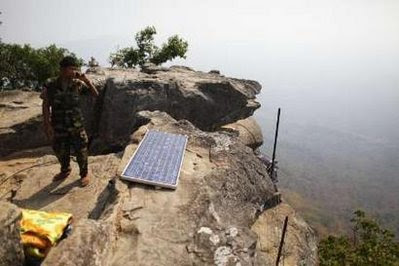Cambodian frontline commander Gen. Chea Tara talks with reporters Cambodia's famed Preah Vihear temple, a UNESCO World Heritage site, in Preah Vihear province,about 245 kilometers (152 miles) north of Phnom Penh, Cambodia, Wednesday, Feb. 9, 2011. Cambodia angrily rejected Thailand's accusation that Cambodian troops used a centuries-old Hindu temple along their disputed border as a military base, revving up a war of words Wednesday amid a fragile truce. (AP Photo/Heng Sinith)
A Cambodian army soldier burns incense stick as he makes prayers next to a Buddhist monk at Cambodia's 11th century Hindu Preah Vihear temple, which wasenlisted as UNESCO's World Heritage, in Preah Vihear province, about 245 kilometers (152 miles) north of Phnom Penh, Cambodia, Wednesday, Feb. 9, 2011. Hundreds of Cambodian soldiers were camped Wednesday at a cliff-top Khmer temple and World Heritage site in the line of fire in deadly border skirmishes with Thailand. (AP Photo/Heng Sinith)
A Cambodian Buddhist monk, right, cooks meals together with army soldiers at Cambodia's 11th century Hindu Preah Vihear temple, which was enlisted as UNESCO'sWorld Heritage, in Preah Vihear province, about 245 kilometers (152 miles) north of Phnom Penh, Cambodia, Wednesday, Feb. 9, 2011. A Cambodian army soldiers through the Cambodia's 11th century Hindu Preah Vihear temple, which was enlisted as UNESCO's World Heritage site in Preah Vihear province, about 245 kilometers (152 miles) north of Phnom Penh, Cambodia, Wednesday, Feb. 9, 2011. Cambodia angrily rejected Thailand's accusation that Cambodian troops used a centuries-old temple along their disputed border as a military base, revving up a war of words Wednesday amid a fragile truce. (AP Photo/Heng Sinith)
Cambodian army soldiers walk around Cambodia's 11th century Hindu Preah Vihear temple, which was enlisted as UNESCO's World Heritage in Preah Vihear province,about 245 kilometers (152 miles) north of Phnom Penh, Cambodia, Wednesday, Feb. 9, 2011. Hundreds of Cambodian soldiers were camped Wednesday at a cliff-top Khmer temple and World Heritage site in the line of fire in deadly border skirmishes with Thailand. (AP Photo/Heng Sinith)
A Cambodian army soldier stands near a crater on the compounds of Cambodia's famed Preah Vihear temple, a UNESCO World Heritage site, in Preah Vihear province,about 245 kilometers (152 miles) north of Phnom Penh, Cambodia, Wednesday, Feb. 9, 2011. Cambodia angrily rejected Thailand's accusation that Cambodian troops used a centuries-old Hindu temple along their disputed border as a military base, revving up a war of words Wednesday amid a fragile truce. (AP Photo/Heng Sinith)
A Cambodian army soldier points at the damaged section of Cambodia's famed Preah Vihear temple, a UNESCO World Heritage site, in Preah Vihear province,about 245 kilometers (152 miles) north of Phnom Penh, Cambodia, Wednesday, Feb. 9, 2011. Cambodia angrily rejected Thailand's accusation that Cambodian troops used a centuries-old Hindu temple along their disputed border as a military base, revving up a war of words Wednesday amid a fragile truce. (AP Photo/Heng Sinith)
A sign is seen under Cambodian and UNESCO flags at the 11th-century Preah Vihear temple on the border between Thailand and Cambodia February 9, 2011. Thailandand Cambodia faced growing diplomatic pressure on Wednesday to end an armed standoff on a stretch of border surrounding the 900-year-old clifftop temple as guns held silent for a second day. REUTERS/Damir Sagolj
An overview of Cambodia's 11th century Hindu Preah Vihear temple, UNESCO's World Heritage, is seen in Preah Vihear province, about 245 kilometers (152miles) north of Phnom Penh, Cambodia, Wednesday, Feb. 9, 2011. Hundreds of Cambodian soldiers were camped Wednesday at a cliff-top Khmer temple and World Heritage site in the line of fire in deadly border skirmishes with Thailand. (AP Photo/Heng Sinith)
Pictures by Radio Free Asia













































































